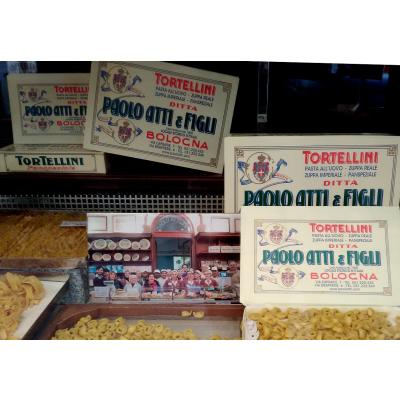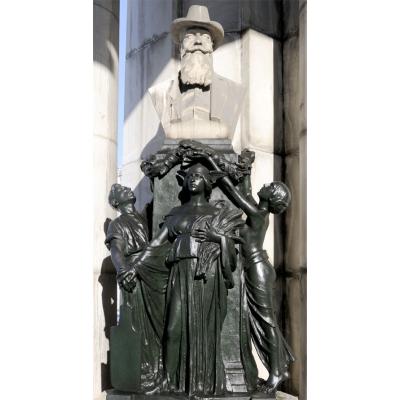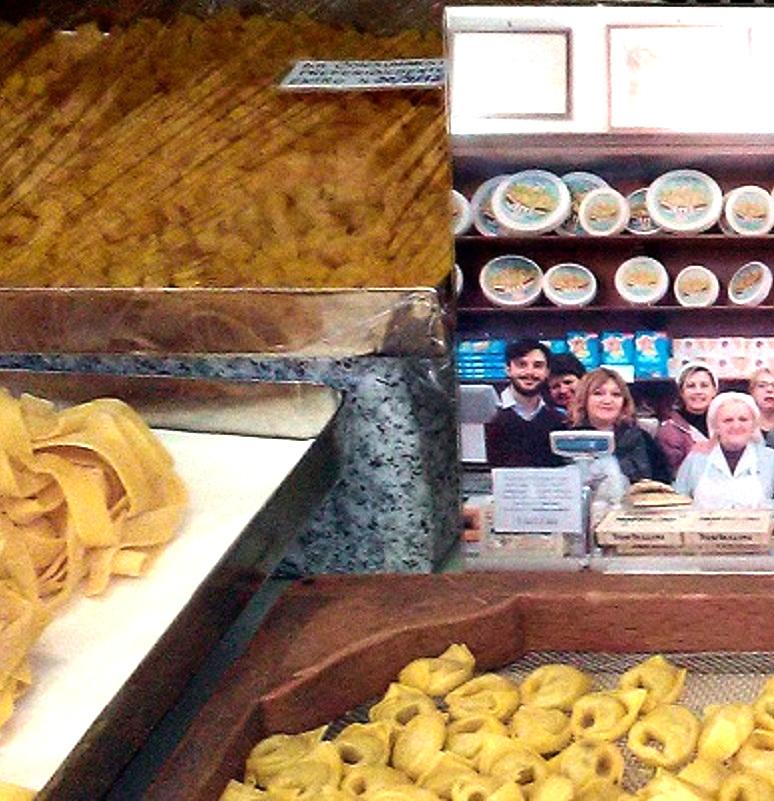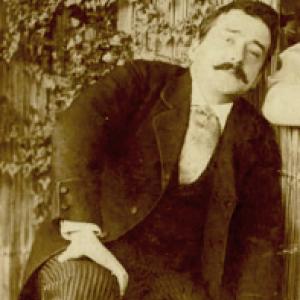Schede
Paolo Atti (1849 - 1910), born into a family of farmers, moved to Bologna at the age of twenty-eight to improve his economic situation. He began as a baker's apprentice and then developed his own business as an entrepreneur. In 1868, he took over the bakery known as “Antico Forno Piemontese”, which had been active since the beginning of the century, renting the premises in Via Drapperie from the Scagliarini family, the owners, and settled with his family in an apartment above the shop. To this day, the sign still bears the original name “Antico Forno Piemontese” and the shop is still run by the family. Having started as an entrepreneur in this way, Atti was producing (and selling) at full capacity in the 1990s; later on, in 1898 smelling the possibility of conquering further portions of the market, he formed a company “in limited partnership for the manufacture of pasta and tortellini” with Enrico Zambelli, owner of the famous pasta factory in Piazza della Mercanzia. Zambelli's company already boasted, among its top products, tortellini and 'luxury pasta' highly appreciated and exported to various countries. Therefore, the agreement with Zambelli represented a turning point in the rise of the entrepreneurial baker, who in 1903 acquired the entire Zambelli property, walls included.
Atti's success, by then well established in Bologna's business lanscape, found its materialisation in the building located in Via Caprarie, still known today as "Palazzo Atti", where the baker and entrepreneur moved the pasta factory, he had taken over a few years earlier, also making sure to make the pasta factory in Via Caprarie and the bakery in Via Drapperie two interconnected buildings. On the facade of the building, the family coat of arms can be seen: ears of wheat gathered in a bunch accompanied by the initials P. A. The specialities of the house were imperial soup, egg pasta with vegetables, tortellini, bread in the Piedmontese, Viennese, Tuscan, French, Genoese, Pisan and obviously Bolognese types; as well as "pastine per ammalati" (pasta of very small cut meant for the sick). The company's products were supported by clever advertising operations that emphasized on the one hand their flavour, authenticity, and high digestibility and on the other the fact that they were exported "all over the world" and the fact that they had won numerous national and international gold medals and diplomas of honour as well as patents from the Royal Houses of Italy and Saxony. The boxes in "Liberty" style containing tortellini and other pastas replicated these honours. Also contributing to the glorification of Atti's tortellini were verses by the dialectal poet Alfredo Testoni and Carlo Zangarini (best known for his famous nursery rhyme advertising Idrolitina, a powder used to prepare sparkling water produced in Italy). Although today it is no longer possible to indicate with certainty the location of all his numerous establishments in various parts of the city, it is certain that he owned a large number of them: in Via Galliera, Via Santo Stefano, Via Ugo Bassi, on the corner of Piazza Aldrovandi and Via San Vitale; he came to own no less than thirteen establishments scattered between Bologna, Florence and Montecatini.
The company name was changed a few times: the company "Paolo Atti e Figlio", set up with his own son Armando, dates back to the period when the family had acquired the Zambelli pasta factory; it then became "Paolo Atti e Figli" when his daughter Margherita also joined the company. The enterprising baker had become part of Bologna's "good society" and the shop in Via Caprarie saw among its regulars Giosue Carducci, Giorgio Morandi and Alfredo Testoni. Paolo Atti died on 12 July 1910; all the factory workers were present at the funeral celebrated in the church of S. Bartolomeo, carrying the Atti White Art flag. Often remembered as a tireless, honest and decisive worker, he is buried at the Certosa Cemetery in Cloister VI (or of the Fallen of the Great War). After his death, the baton was passed to his children Armando and Margherita. The latter, later left alone at the helm of the company, was then joined by her own daughter Paola.
In the 1940s, the building in Via Drapperie was donated by the last heir of the Scagliarini family to the Ricovero di Mendicità (an association aiming to take care of the homeless). Today the business is concentrated in Via Drapperie and in the Via Caprarie establishment owned by the descendants of Paolo Atti.
Stefano Lollini
Translation by Lorenzo Rocco, 2022. Bibliography: G. Maioli – G. Roversi, Sua Maestà il Tortellino, Bologna, Re Enzo Ed., 1993; Bologna in cucina. Ricette di famiglia dal 1880, a cura di B. Spagnoli, Bologna, L’artiere Edizionitalia, 20083; R. Martorelli, Un percorso dell’economia bolognese nella Certosa, in La ruota e l’incudine. La memoria dell’industria meccanica bolognese in Certosa, a cura di A. Campigotto – R. Martorelli, Bologna, Minerva, 2016.







